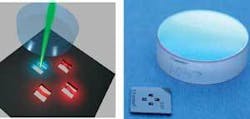LASER COOLING: Optomechanical sensing gets very cool indeed
Radiation pressure-the ever-present but (usually) exceptionally weak effect of incident light-is already predicted to play a role in some of the most sensitive optical measurements, such as the next generation of gravitational-wave interferometers. But recent work by Pierre-François Cohadon and his group at the Laboratoire Kastler Brossel (Paris, France) has for the first time experimentally confirmed the prediction that radiation pressure can passively cool microresonator mirrors, driving them to temperatures as low as 10 K.1 The result is promising for the pursuit of one of the “holy grails” of condensed-matter research: reaching the quantum ground state of a macroscopic resonator. The method has been shown to measure the displacements of a microresonator mirror with a thousandfold improvement in sensitivity over previous methods.
The researchers cut 1-mm-long holes 1 mm apart in a silicon wafer using deep reactive-ion etching, forming a doubly clamped silicon beam (see figure) to form one mirror of a Fabry-Perot cavity. The other, a standard curved low-loss coated silica mirror, was used to couple in a highly stable 1064 nm TEM00 laser beam. The technique relies on the Pound-Drever-Hall technique, a feedback approach in which the laser is phase-modulated and the relative phase of the reflected sidebands compared. At low frequencies, the resulting error signal helps to cavity-lock the resonator and the incident laser; at higher frequencies, it provides a measure of the displacements of the resonator mirror.
Previously such optical-sensing attempts have used resonators with a finesse (a measure of the reflectivity of the optics and thus the sharpness of the cavity resonance) on the order of 10. The quality of the substrates and coatings in the new research resulted in a finesse of 30,000. Such a high finesse allows a high cavity-storage time, or number of round trips in the cavity, effectively increasing the sensitivity of the displacement measurement to 4 × 10-19 mHz -1/2 at 1 MHz. This sensitivity-corresponding to a billionth of the size of a single atom for a 1 s measurement time-represents an improvement of three orders of magnitude over the best previous approach of using single-electron transistors as detectors in nanoscale resonators.2
Passive radiation cooling
But the most significant result, says Cohadon, is the demonstration of cooling solely due to radiation pressure. In 1999, the same team pioneered an active, feedback-controlled cooling mechanism that registered the displacements of a cavity mirror and canceled them with externally applied radiation pressure in a scheme akin to noise-canceling headphones.3 But in the new work, Cohadon says, “the intracavity radiation pressure does everything by itself; it is a ‘passive’ mechanism.”
Nonlinear coupling between mirror motion and the optical field results in an “optical-spring” effect: by detuning the cavity from resonance, the intracavity radiation pressure is modified by the mirror’s motion and the corresponding radiation pressure modifies the effective “spring constant.” The finite storage time of the cavity creates a lag between mirror displacements and changes in the force, and the mirror is subjected to a force with a component proportional to its velocity. The result is additional damping-made significant by the high-finesse cavity-that effectively quenches the Brownian motion of the mirror, lowering its temperature.
Such self-cooling techniques are a tantalizing prospect for those who work at the border between classical and quantum physics; the researchers have already characterized their system for experiments in search of macroscopic quantum ground states and zero-point fluctuations.4 With only the quantum noise as a fundamental limit, the next steps are the study of the quantum aspects of both the resonators themselves and the light field contained within.
In contrast to the previous most effective nanoresonator approach, the current method must necessarily use resonators at least as big as the micron-scale laser spot, meaning lower displacements and lower ultimate temperatures required to reach the quantum ground state. But Cohadon is convinced that the technique can do the cooling itself and has sensitivity to spare, noting that there is room for improvement in the finesse limited only by the quality of the resonator optics.
“As for the long-term goal to see the quantum ground state of a mechanical resonator,” he says, “performing the experiment at liquid-helium temperature or below is of course a required beginning.” That gives a head start of two orders of magnitude in temperature. From there, the passive-cooling mechanism should bring the experiment firmly up against Heisenberg’s limit, at which point condensed-matter research will truly make a quantum leap.
REFERENCES
1. Arcizet et. al., Nature 444, 71 (2006).
2. LaHaye et. al., Science 304, 74 (2004).
3. Cohadon et. al., Phys. Rev. Lett. 83, 3174 (1999).
4. Arcizet et. al., Phys. Rev. Lett. 97, 133601 (2006).
